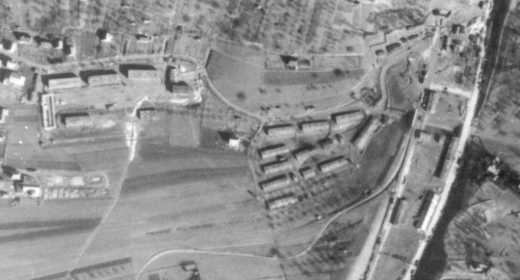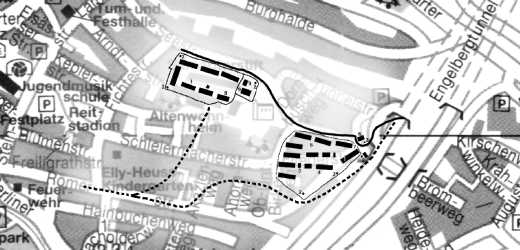The concentration camp (KZ) in Leonberg
From spring 1944 to April 1945 there was an outpost of the Natzweiler concentration camp (Alsace) run by the “SS” in the upper “Seestrasse”. It was safeguarded with barbed wire and watch-towers.
Prisoners from 24 European countries, mainly from Poland, the USSR, France, Hungary, the Balkans and Germany were held captive in the shacks. The prisoners almost exclusively worked for the “Presswerk Leonberg”, a branch of the Messerschmitt AG company, based in Augsburg.
In April 1945, the machines were removed and the camp was cleared because of the approaching French troops. A mass grave on the Blosenberg for the dead prisoners, whose death was caused by the catastrophic working and imprisonment conditions, was all that remained.
Many people from Leonberg tried to ignore the camp's existence and looked away when they bumped into a number of prisoners on the street. A few inhabitants, however, helped them, risking Draconian measures by doing this.
The old and the new camp
The old (right) and the new camp (left) between motorway and Leonberg.
Aerial photograph, Royal Airforce 2 March 1945
Key to the plan of the new camp:
Watchtowers can be seen at the corners of the compound.The three completed oblong two-storey buildings along the Seestrasse housed the prisoners.
Opposite on the left hand side: the kitchen Opposite on the right hand side: disinfection block
The two buildings on the far right: for guards.
Key to the plan of the old camp:
You can see watchtowers at the corners of the compound. On the large parade ground: a gallows
In the second row from the bottom: mortuary and sick bay.
The oblong building on the right edge: kitchen and stores. Next to it was the entrance to the camp.
In the sharp bend of the marked path outside the compound fence, opposite the entrance: pond with water used for firefighting, which is still a pond today (now on private property).
Further features:
The dotted line: narrow-gauge railway of the Leonberg plaster factory (today the city hall), that was extended from the station to the "new camp" and the workplace in the Engelberg tunnel.

